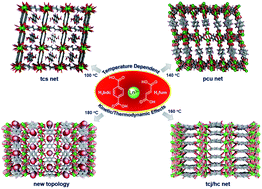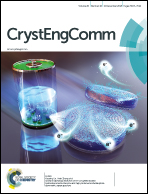Temperature-dependent 3D structures of lanthanide coordination polymers based on dicarboxylate mixed ligands†
Abstract
Fourteen three-dimensional (3D) lanthanide coordination polymers (CPs) with dicarboxylate mixed ligands, [Ln(fum)1.5(H2O)2]·0.5(H2bdc)·H2O (Ln = Sm (1), Tb (2)), [Ln2(fum)2(bdc)(H2O)4]·2H2O (Ln = Sm (3), Eu (4), Tb (5), Er (6)), [Ln(fum)0.5(bdc)] (Ln = Sm (7), Eu (8), Tb (9), Er (10)), and [Ln2(bdc)2(ox)(H2O)4]·0.7H2O (Ln = Sm (11), Gd (12), Tb (13), Dy (14)), have been synthesized hydrothermally from the self-assembly of lanthanide(III) ions (Ln3+), fumaric acid (H2fum), and terephthalic acid (H2bdc) in the presence of potassium hydroxide at different temperatures. The compounds fall into four classes. Compounds 1 and 2 were isolated from hydrothermal reactions performed at a relatively low temperature of 100 °C and found to crystallize in the triclinic space group P![[1 with combining macron]](https://www.rsc.org/images/entities/char_0031_0304.gif) . The 3D framework is assembled from 2D layers of [Ln(fum)(H2O)2] units pillared by the chelating fum ligands and has 1D rhombic channels templated by H2bdc and lattice H2O molecules. The framework presents a binodal (4,5)-connected tcs topology with the point symbol (44·62)(44·66). Raising the reaction temperature to 140 °C resulted in the formation of compounds 3–6. These materials crystallize in the monoclinic system with the polar space group P21 and feature a 3D network constructed from dinuclear {Ln2(OCO)6(H2O)4} units interlinked by fum and bdc ligands, showing a uninodal 6-connected two-fold interpenetrated pcu topology. The small channels of the framework are occupied by lattice H2O molecules. Further increase of the reaction temperature to 160 °C gave rise to the formation of compounds 7–10, crystallizing in the orthorhombic space group Pbca. The 3D framework is generated from 2D corrugated sheets of [Ln(fum)]2+ bound by bdc ligands and contains no intercalated H2O molecules in the lattice. The framework possesses a trinodal (4,6,7)-connected net with the point symbol (42·64)2(46·68·8)(412·69)2. Finally, compounds 11–14 contained an in situ generated oxalate (ox) ligand formed under hydrothermal conditions conducted at a high reaction temperature of 180 °C. These compounds crystallize in the monoclinic space group P21/c and possess a 3D open framework consisting of a dinuclear [Ln2(ox)(H2O)4]2+ unit linked by bridging bdc ligands and has small void channels occupied by lattice H2O molecules. The frameworks were topologically simplified as a binodal (4,5)-connected tcj/hc net with a total point symbol of (42·52·72)(42·53·75). In the solid state at room temperature, the Tb (2, 5, 9, and 13) and Eu (4 and 8) compounds emit green and red light, respectively.
. The 3D framework is assembled from 2D layers of [Ln(fum)(H2O)2] units pillared by the chelating fum ligands and has 1D rhombic channels templated by H2bdc and lattice H2O molecules. The framework presents a binodal (4,5)-connected tcs topology with the point symbol (44·62)(44·66). Raising the reaction temperature to 140 °C resulted in the formation of compounds 3–6. These materials crystallize in the monoclinic system with the polar space group P21 and feature a 3D network constructed from dinuclear {Ln2(OCO)6(H2O)4} units interlinked by fum and bdc ligands, showing a uninodal 6-connected two-fold interpenetrated pcu topology. The small channels of the framework are occupied by lattice H2O molecules. Further increase of the reaction temperature to 160 °C gave rise to the formation of compounds 7–10, crystallizing in the orthorhombic space group Pbca. The 3D framework is generated from 2D corrugated sheets of [Ln(fum)]2+ bound by bdc ligands and contains no intercalated H2O molecules in the lattice. The framework possesses a trinodal (4,6,7)-connected net with the point symbol (42·64)2(46·68·8)(412·69)2. Finally, compounds 11–14 contained an in situ generated oxalate (ox) ligand formed under hydrothermal conditions conducted at a high reaction temperature of 180 °C. These compounds crystallize in the monoclinic space group P21/c and possess a 3D open framework consisting of a dinuclear [Ln2(ox)(H2O)4]2+ unit linked by bridging bdc ligands and has small void channels occupied by lattice H2O molecules. The frameworks were topologically simplified as a binodal (4,5)-connected tcj/hc net with a total point symbol of (42·52·72)(42·53·75). In the solid state at room temperature, the Tb (2, 5, 9, and 13) and Eu (4 and 8) compounds emit green and red light, respectively.



 Please wait while we load your content...
Please wait while we load your content...